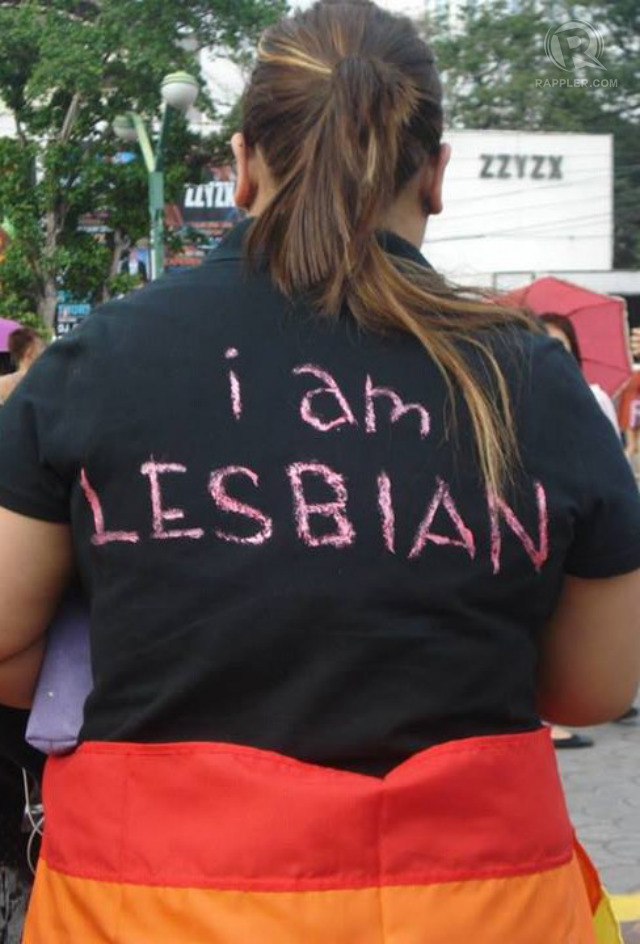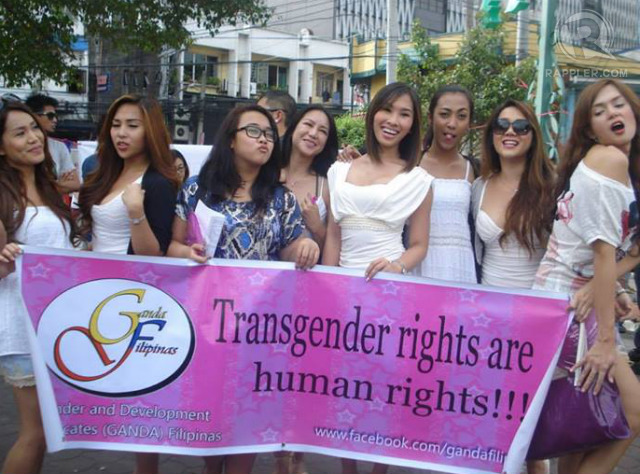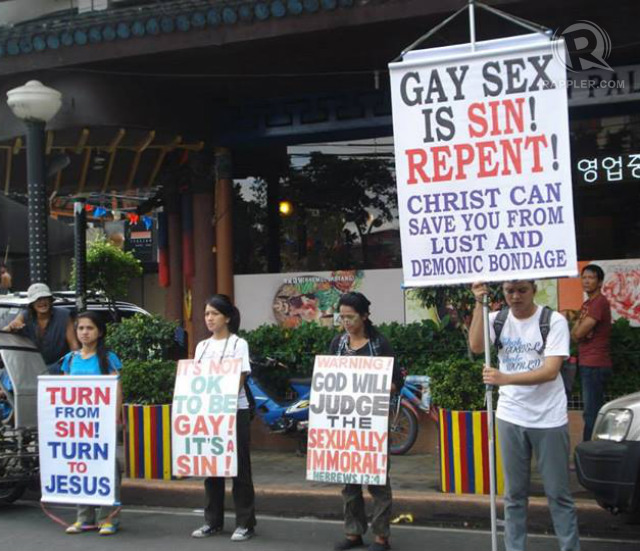SUMMARY
This is AI generated summarization, which may have errors. For context, always refer to the full article.

MANILA, Philippines – It has been 19 years since the first organized gay pride parade in the Philippines.
At that time, openly gay and lesbian groups were a rarity. Boundaries had to be pushed. Attendance was at a minimum.
Rev Fr Richard Mickley of the Metropolitan Community Church (MCC) Philippines recalls the June 1994 march clearly. MCC – the church he founded which welcomes members of the lesbian, gay, bisexual, transgender, and queer (LGBTQ) community – was among the two participating organizations of the country’s first LGBTQ pride march.
“We got lots of publicity and things started happening… We went on Mel & Jay (a local talk show). Through the years, there has been change in the mindset of the people. Millions of people now believe that there is an alternative to the teachings of the Catholic Church,” he said in an interview with Rappler.
The Philippines remains largely Catholic, although with dwindling Church attendance and a relatively low level of religiosity.
To fight long-standing stereotypes and generalizations, Mickley believes that visibility is important for the LGBTQ movement.
“Because they wanna sweep us under the rug. They wanna pretend that we don’t exist. We want to show that we are here. We are everywhere. We are honorable. We are proud of who we are,” he explained.
Every year since 1994, LGBTQ rights advocates and supporters gather in Manila to express solidarity with one another. The Metro Manila Pride March is reported to be the oldest annual gay pride parade in Asia.

2013 Pride March
Jade Tamboon, head coordinator of the Task Force Pride Philippines, co-organized the 2013 march held Saturday, December 7. He has been part of the organizing committee for two years now.
“The theme and the tone of the parade reflects the sociopolitical atmosphere during that time,” he said. “For this year, our theme is strength in colors. It emphasizes the ability of the LGBTQ community to rise up from oppression.”
Tamboon acknowledged that social perceptions have become more accommodating of the LGBTQ community, but believes more can be done to fight discrimination.
“In the country, there’s still no legislation that guarantees equal rights for everybody regardless of sexual orientation or gender identity. Even though the Philippines is somehow presented as an LGBT-friendly nation, that seems superficial. Underneath that, if you look deeply, you could see little signs of oppression,” he said. (READ: Is the Philippines really gay-friendly?)
“We, the LGBT community, we’re used to oppression, but we rise up from it,” he added, citing cases of sexual discrimination at work and even simple teasing that could escalate to bullying.
The 2013 Pride March, he said, sought to highlight the movement’s capacity to rise from oppression. “Our strength, our ability to cope, our ability to recover,” said Tamboon, hopefully serves as an inspiration for other suffering Filipinos.
The event also featured a donation drive for victims of Super Typhoon Yolanda (Haiyan) that brought massive destruction to key cities in Eastern Visayas.

Forward strides
Naomi Fontanos, executive director of Gender and Development Advocates (GANDA) Filipinas, was also among the organizers of the 2013 pride parade.
To Fontanos, it was a means for the Filipino LGBTQ community to celebrate the successes they’ve had from 2012 to 2013.
“In the past year, we saw more people from the LGBTQ community engage in politics. We saw the passage of anti-discrimination ordinances in different cities… [There is also] a newly-filed anti-discrimination bill in Congress,” she explained.
Fontanos, however, was dismayed by the lack of LGBTQ representation in the country’s legislative body. In the May 2013 polls, Ang Ladlad Party-list ran for a seat in Congress but lost.
Not much has changed in terms of legally enforceable LGBTQ rights since the first pride march in the country in 1994. Various versions of an anti-discrimination legislation have surfaced in Congress, but no law has been enacted to date.
Nevertherless, Fontanos is happy that there are forward strides.
“Every year, organizations come and go. But every year, we have new blood to fight for LGBTQ human rights in the Philippines,” she said.
Hate crimes
On August 3, the Philippine Commission on Human Rights (CHR) made a move to protect the interests of the LGBTQ community.
It decided to document hate crimes – violence done on the basis of the victim’s sexual orientation and gender identity (SOGI) – against LGBTs across the country.
“These are not just common crimes. They (the victims) belong to the marginal and discriminated sectors of society. These are people who are discriminated against — binaril, tinotorture, ninanakawan— dahil galit dahil sa sexual orientation niya,” explained CHR Chairperson Loretta “Etta” Rosales. (These are people who are discriminated against — shot, tortured, robbed — because of anger over their sexual orientation.)
According to data collated by the Philippine LGBT Hate Crime Watch, there have been around 164 cases of murdered LGBTs in the country from 1996 to June 2012.
The creation of safe spaces – establishments where LGBTs can freely express their sexual orientation and gender identity – and the conduct of gender sensitivity training in law enforcement agencies are among the things that advocates continue to fight for.

Movement’s growth
Mickley said homophobia is still a huge concern for many members of the Filipino LGBTQ community.
“It’s not an easy thing to deal with. I always tell people, ‘It’s your choice.’ Do you want to run and hide or do you want to be who you are?” he asked.
MCC, he said, continues to develop support groups for the struggling Filipino LGBTQ.
“Know who you are. Choose to be who you are,” he said, with a conviction that the growth of the movement is an indication that better things are yet to come.
Over 50 organizations participated in this year’s pride march. Among those in attendance were: Accenture FLAG – LGBT Philippines, Akbayan LGBT, Akei, Amnesty International, Association of Transgenders in the Philippines, BATSI (Bataan), Equality Alliance, Equality Philippines, Filipino Freethinkers, Foundation for Media Alternatives, Galang, GANDA Filipinas, Gay Geeks, Gayon Albay LGBT Organization, G-Male Philippines (Clan), JPMorgan Chase & Co., Kapatid LGBT Community, Ladlad, Lesbian Activism Project (LeAP), Lesbian Alliance Bagbag, Lesbian Alliance Movement: Lakas ng Kababaihan para sa Karapatan, Lesbian For Rights, Lezworld, Love Yourself, Malaya LGBT, MCC QC, MCC Makati, MCC Marikina, MCC Metro Baguio, MCC Olongapo, Metro Guys Society (Clan), Outrage, One Bacardi, Philippine Atheists and Agnostics Society (PATAS), Pink Rockers, Pinoy Deaf Rainbow, Pinoy FTM, Pinoy G4M, PLM Propaganda, Rainbow Rights Project, Rhythm Curve Clan & Lesbian Society of the Philippines, Society of Transexual Women of the Philippines (STRAP), Tegan and Sara Made Me Do It Clothing, Tingug CDO, Transman Pilipinas, Trippers Pilipinas, Ugnayan ng Nagkakaisang Lesbyana Laban sa Diskriminasyon, UP Diliman Ladlad, Valenzuela LGBT, Women’s Legal and Human Rights Bureau, and Xroads. – Rappler.com
Add a comment
How does this make you feel?
There are no comments yet. Add your comment to start the conversation.